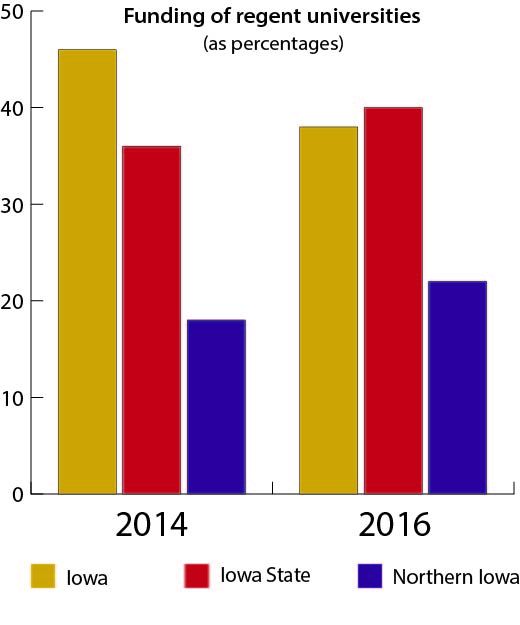Regents request $12.9 million for new funding model
Funding chart
September 17, 2014
Iowa State and the University of Northern Iowa could see a few million dollars in budget increases with a new funding model adopted by the Board of Regents.
The model, approved by the board in June, would favor universities with higher in-state enrollment, graduation rates and retention rates.
The largest factor in the model is undergraduate resident enrollment.
The amount of resident undergraduates at a university has a weight of 60 percent in the model, which is why Iowa State and Northern Iowa would receive more funding.
The University of Iowa has the least amount of in-state students at 17,000 last year, which is 55 percent of the student body, while Iowa State has the largest number of the three universities — about 22,000 last year, which is 66 percent of the undergraduates.
“Right now, the feeling is the way these appropriations are allocated among the three regent universities isn’t equitable to enrollment numbers,” said Warren Madden, senior vice president for business and finance.
Madden said Iowa State is receiving less money per student than the University of Iowa under the current allocation system.
The regents are asking the state for $12.9 million in the next legislative session to pay the transition into the new model to offset the $12.9 million that would have been reallocated from Iowa to Iowa State and Northern Iowa.
“By funding the performance-based funding, the state can minimize any short term disruptions caused by those reallocations,” said Patrice Sayre, regents business officer, at the September meeting.
The funding model is a link from taxpayer dollars to how higher education is funded, Sayre said.
“The significant contribution [of] this new approach is to award each institution for achieving the objectives of the state,” Sayre said. “It is not meant to create competition.”
Currently, the University of Iowa receives 46 percent of the state’s funding, Iowa State gets 36 percent and Northern Iowa receives the final 18 percent.
The change, Sayre said, would drop the University of Iowa’s portion to 38 percent. Iowa State’s and Northern Iowa’s funding would rise to about 40 and 22 percent respectively.
If the request is approved by the legislature later this academic year, the board is planning a three-year transition into the funding model with a 2 percent cap on the amount of money reallocated.
At Northern Iowa, 92 percent of the student body is from Iowa according to last year’s enrollment numbers.
Lindsay Cunningham with Northern Iowa university relations said the new model would benefit the smallest of the three regent schools.
“The money that we will get would be positive for UNI because we have been underfunded for years,” Cunningham said. “This will help get us to the same place Iowa State and Iowa [are] in terms of general funding.”
Madden said the funding would also be positive for Iowa State.
“If this money is appropriated, it will provide additional support to Iowa State to respond to the growing enrollments, hire more faculty, provide more facilities and make the campus function better,” Madden said.
Regents Subhash Sahai and Larry McKibben both expressed concern regarding Iowa’s lessened funding at the regents meeting in September.
“I struggle with this in-state funding appropriation that we have,” Sahai said. “Sixty percent, to me, is out of proportion. I think taking that sum of money from [University of Iowa] and going to the other two schools is going to have a great impact.”
Regent Larry McKibben said he supports giving more money to Iowa State and Northern Iowa, but he also said he doesn’t support taking that money from Iowa if the requested supplemental money is not approved by the state.
“The University of Iowa looks forward to working with the Board of Regents, state of Iowa, the Governor, and the general assembly on the Performance-based funding model and the supplementary funding request approved by the board,” according to a University of Iowa email statement in response to an Iowa State Daily comment request. “The [University of Iowa] is also poised to grow and serve more Iowans. We are excited for the future because of those opportunities.”
The regents’ budget still has to be approved and signed by the governor of Iowa and the legislature in the spring.







